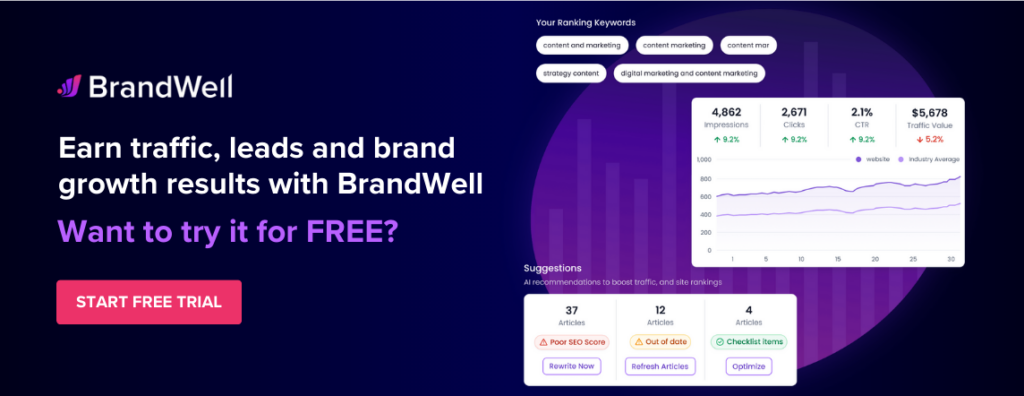Discover top guides, trends, tips and expertise from AIO Writers

Bad copy can do serious damage to your brand. It can turn off readers too — sloppy editing can lead to an 85% increase in bounce rate.
Our guide to copywriting in marketing will help you prevent these disasters by helping you create compelling copies that increase engagement, boost brand awareness, and generate leads.
In this article, we’ll cover what is great copywriting, what are the elements of marketing copy, what a copywriter does in marketing, and tips on how to improve your copywriting skills.
Let’s dive into our comprehensive guide to copywriting in marketing so you can start writing persuasive sales copy.
Table of Contents:
- What is Copywriting?
- Why is Copywriting Important?
- Elements of Marketing Copy
- What Makes Good Copy?
- What Does a Copywriter Do in Marketing?
- Beginners Guide to Copywriting in Marketing
- How to Write Persuasive Copy
- Copywriting Checklist
- Common Mistakes to Avoid When Writing Marketing Copy
- Guide to Copywriting in Marketing: Improve Your Copy Right Now
- Learning from Top Copywriters in Marketing
- FAQs – Guide to Copywriting in Marketing
- Conclusion
What is Copywriting?
Copywriting is the process of creating persuasive and engaging content for marketing purposes. Writing copy focuses on selling products or services rather than just informing readers.
Good marketing copy will persuade potential customers to take action. This may be signing up for an email list or buying a product.
The goal of effective copywriting strategies is to capture the interest of the audience and ultimately convert them into paying customers.
There are many ways to write copy. Some of the most common copy formats are:
- Website copy (landing pages).
- Sales letters.
- Email copywriting.
- Ads (direct response).
- Blog posts (content marketing).
- Press releases (public relations).
- White papers (corporate communications).
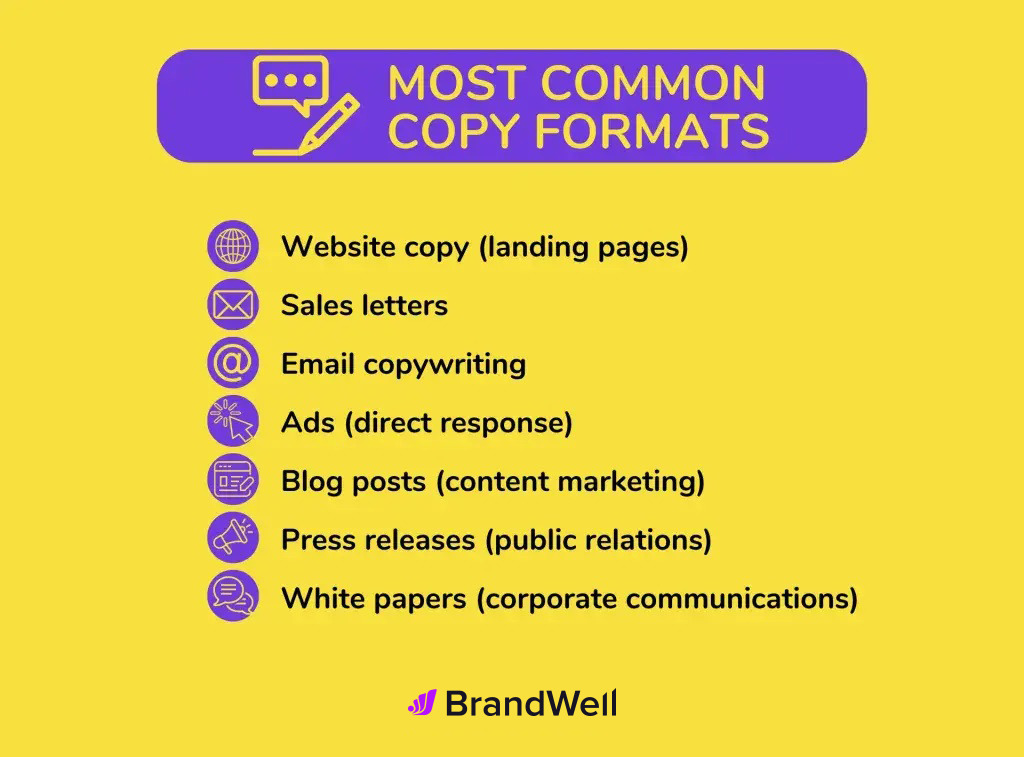
Each copywriting process has its own style, depending on your intended purpose and desired outcome.
Why is Copywriting Important?
Good copywriting has the power to capture attention and draw people into your brand story. It can also help you build trust with potential customers by providing valuable information about your products or services. With compelling copy, you can increase conversions and boost sales while creating meaningful relationships with customers.
The main advantage of copywriting is its ability to drive readers to act. By writing persuasive messages that speak directly to their needs and interests, copywriters can convince readers to complete actions that profit a brand, like signing up for a newsletter, downloading a freebie, or even buying something. This helps companies maximize their return on investment (ROI) from their marketing efforts by converting more leads into paying customers.
Another benefit of copywriting is its ability to improve search engine rankings through keyword optimization techniques. SEO helps search engines better understand what topics are being discussed on each page so they can rank them higher in search results.
Additionally, good copywriters know how to use storytelling techniques like metaphors and analogies which make it easier for readers to comprehend complex concepts without getting bored or overwhelmed by too much technical jargon.

Screenshot from Indeed
Elements of Marketing Copy
There are four essential elements to every type of marketing copy: writing style and tone, structure and flow, language and imagery, and call to action.
Writing Style and Tone
Your writing style is key to copywriting success.
First, it should be appropriate for the target audience.
Second, it should reflect their interests, needs, and values to encourage engagement.
For example, if you’re targeting Gen Z students then your tone might be more conversational and informal.
On the other hand, if you’re targeting Boomer professionals then a more formal approach would be more appropriate.
Learn how to analyze your audience to create great copy.
Structure and Flow
Successful copywriting leads the reader through an easy-to-follow structure from start to finish. Sentences should be concise yet informative so they can quickly understand what you’re talking about. Good flow ensures that readers stay on track until they reach the end of your copy where they’ll find your CTA (call-to-action).
Language and Imagery
When you write copy, think about how your target audience speaks. Your choice of words should create vivid images in readers’ minds that evoke emotion — ranging from joyous excitement to sadness or fear, depending on what kind of message you want to deliver.
Additionally, the best copywriting strategies integrate appropriate visuals such as photos or videos to help break up blocks of text and provide visual context for whatever it is you’re trying to communicate.
Call to Action
Want to increase your conversion rates by a whopping 202%? Personalized calls to action are the key.
Every good piece of copywriting needs a clear CTA. The call to action is the part where you tell your reader what to do after reading your content. This can involve subscribing to an email list, buying a product, or contacting you.
Your CTA must stand out so make sure it’s written clearly and with a sense of urgency. “Sign up now” is a better CTA than “Contact us”.
Consider all these copywriting elements when crafting great copywriting strategies. Knowing the importance of flow, structure, language, and imagery will help you create content that keeps audiences hooked.
What Makes Good Copy
Good copywriting can help you capture the attention of potential customers, build trust and credibility, and drive conversions.
But what exactly makes up good copy?
- Clarity: Good copy should be clear and concise so that readers understand it easily. Focus on writing in plain English with short sentences that get straight to the point.
- Relevance: Make sure your message addresses the needs or interests of your audience. If you’re talking about a product or service, explain how it will benefit them specifically rather than just listing features without context.
- Engagement: Keep readers engaged by telling stories or providing interesting facts related to the topic at hand. This helps keep them interested in reading more! You can also use visuals such as images, videos, and infographics which often work better at capturing attention online.
- Emotion: People make decisions based on emotion rather than logic, so try to evoke feelings like excitement, curiosity, or joy through your words. This could mean creating suspenseful headlines that leave people wanting more or adding humor into the mix if appropriate for your brand voice.
In the next section of this guide to copywriting in marketing, we’ll define the role of a copywriter.
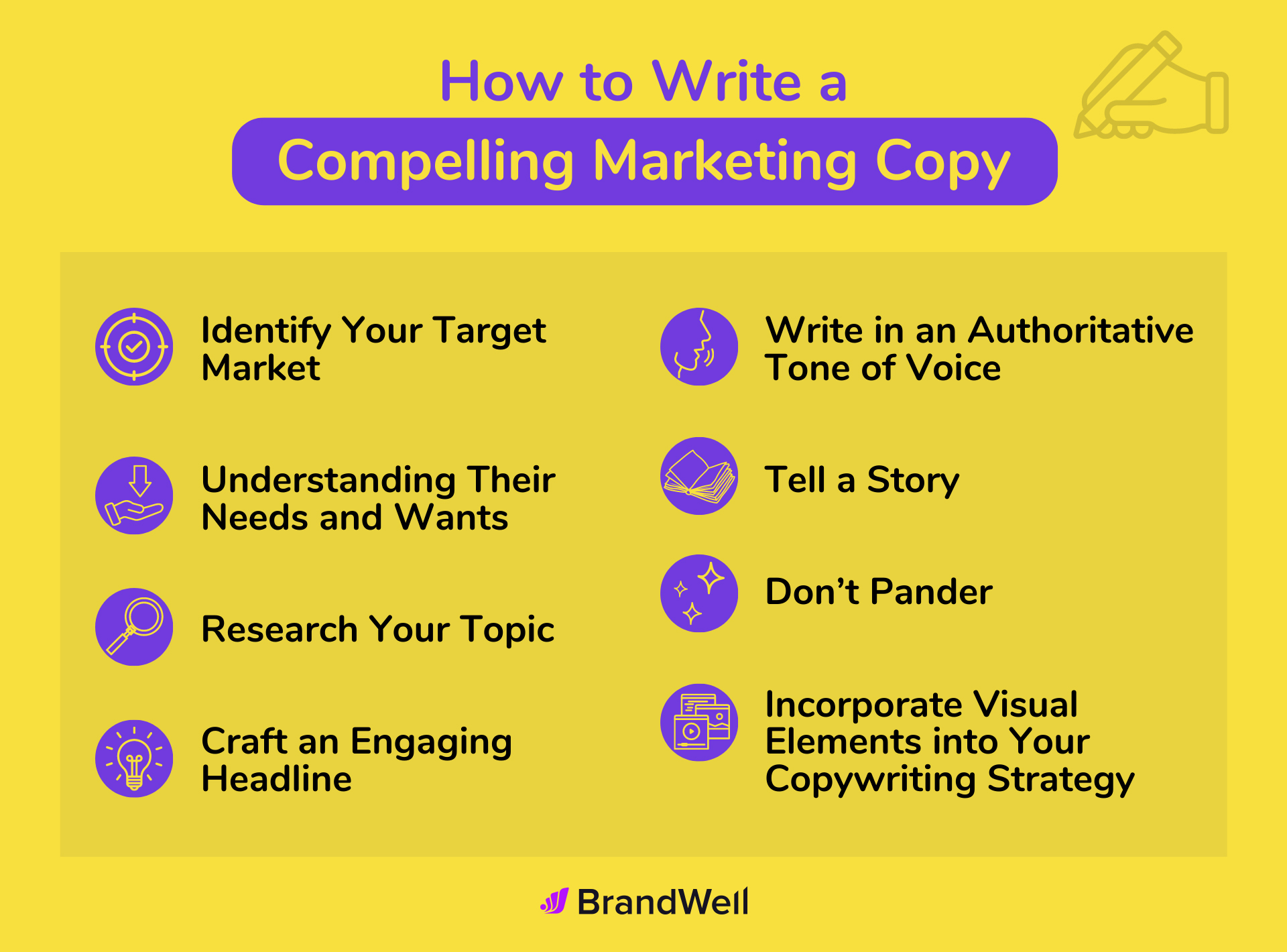
What Does a Copywriter Do in Marketing?
A copywriter is a key player in any successful marketing team. Good copywriting skills are essential in crafting persuasive material to engage the intended demographic and spur them into action.
If you’re looking to build a content team, among the copywriting skills you should look for are research, content marketing for different platforms, SEO, and data analytics.
Copywriters must understand who they’re writing for so they can create tailored content. This involves studying demographics, understanding customer behavior patterns, and analyzing data from surveys or interviews with customers. With this information in hand, copywriters can then write effective messaging that resonates with their intended audience.
Successful copywriting also requires crafting engaging content across multiple channels including web pages, email newsletters, and social media posts. Content should not only be interesting but also informative enough to grab readers’ attention – all within a few seconds. Keep messages short yet impactful by using language that appeals directly to your target market.
Another important copywriting skill is SEO. Optimizing content is crucial in driving organic traffic to your website through search engine rankings. All copywriters should have a basic knowledge of how to optimize content, including where and when to place keywords.
Copywriters should also have basic knowledge of data analysis so they can see how well campaigns have performed and make adjustments according to customer responses.
The copywriting process plays an important role in marketing campaigns as it allows brands to connect with potential customers through creative writing. In the next part of this guide to copywriting in marketing, we’ll explore how aspiring copywriters can hone their skills in writing ad copy.
Beginners Guide to Copywriting in Marketing
Because the copywriting process is an important part of marketing, it’s important to get it right. For those who are still starting out, here are some copywriting tips on how to become a more proficient writer.
The first step in developing your writing skills is to read as many materials as you can in your chosen genre. Gather insights from different writers and authors to sharpen your own technique.
It’s also important to hone your research skills. Know what your audience needs so that your copy speaks directly to them. Learning about their demographics, interests, and lifestyle choices will give you insight into what kind of language they best respond to.
Finally, knowing the basics of SEO can help boost the visibility of your content online. Keywords are especially important so make sure they appear throughout the text without being forced or overly repetitive.
These three tips – developing writing skills, researching your target audience, and mastering SEO strategies – are all essential elements for beginner copywriters looking to break into the field of marketing. With practice and dedication, anyone can become a successful copywriter.
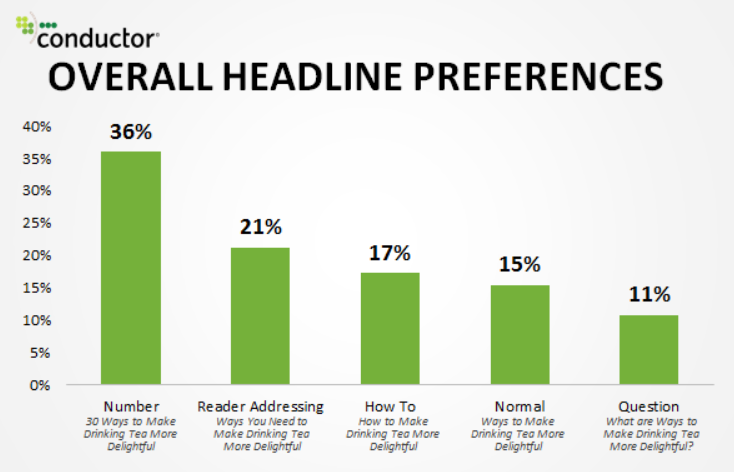
Screenshot from Moz
How to Write Persuasive Copy
Copywriting is all about getting your value proposition across persuasively.
A value proposition should be clear and concise, explaining why someone should choose your product or service over others. It should also explain how it can help solve their problem or fulfill their needs or desires.
For example, Moz’s homepage states that they “help marketers and business owners get better results from their websites by providing them with the tools they need to measure performance, optimize content, track rankings, monitor backlinks, analyze competitors and more” — all of which are benefits that potential customers would find appealing.
Here are some other foundations for writing persuasive copy.
Know Your Brand Voice
Brand voice is important in any guide to copywriting in marketing.
Your brand voice is the distinct personality that you display in all of your marketing channels, including your website, blog posts, emails, social media posts, and advertisements.
Think of your brand as if it were a person.
What kind of language do they use? Are they serious or playful? Do they sound like an expert mentor or a close friend?
The answers to these questions will help define the brand voice.
It’s important to note that there’s a difference between tone and voice when it comes to branding. While your brand’s voice should remain consistent across all platforms, the tone can vary depending on the audience and purpose of your message.
For example, holiday cheer emails will have a different tone than an urgent sale ad copy. The key here is understanding how each platform works best for communicating with customers while still staying true to your overall identity as a company.
When creating content for any channel, make sure it aligns with the core values of your business and reflects its mission statement accurately so that readers know who you are right away.
Explain Benefits Clearly and Concisely
When writing copy, make sure to clearly explain the benefits of using your product or service as opposed to just listing features that may not mean much to readers.
Instead, focus on how these features will improve their lives in some way – whether it’s saving time, money, or effort.
Appeal to Emotions
Writing persuasive copy that appeals to emotions can be a powerful way to engage your audience and motivate them to take action.
- Identify emotional triggers: Emotional triggers are specific emotions that can influence decision-making. Appeal to strong positive emotions (joy, hope) as well as negative ones (fear, frustration) where relevant. Remember: balance is key. Too much negativity might turn off potential customers while excessive positivity may come across as insincere.
- Tell a story: Storytelling is a powerful tool for evoking emotions. Create relatable stories around your product rather than stating bland features and show how your product can transform people’s lives.
- Choose vivid and sensory language: Use descriptive and sensory words to create a vivid picture in the reader’s mind. Appeal to their senses by using words that evoke emotions and make the copy more engaging.
- Show empathy: Acknowledge your audience’s pain points and demonstrate how your offering can provide a solution or relief. By connecting on an emotional level, you build trust and credibility.
- Create a sense of urgency: Appeal to the fear of missing out or the desire for immediate gratification by emphasizing limited-time offers, exclusive deals, or limited stock availability. This can help create a sense of urgency and prompt action.
- Use persuasive language: Utilize rhetorical devices like repetition, alliteration, metaphors, and rhetorical questions to make your copy more persuasive and memorable. These techniques can create an emotional impact and drive your message home.
- Include a strong call to action: Clearly state what you want your audience to do next. Use action-oriented words and phrases that create a sense of urgency and excitement. Make it easy for them to take the desired action by providing clear instructions. For instance, “Join us today and conquer loneliness” could work better than “Sign up now.” It appeals directly to feelings thus increasing chances for conversions.
Add Visuals to Your Copy
Adding visuals to your copy can majorly boost its impact and appeal. Visual elements have the power to grab attention, evoke emotions, and convey information quickly.
Visual elements also help break up text-heavy pages while helping readers visualize what you are talking about. This can be especially helpful when you’re trying to explain technical concepts that might otherwise go over people’s heads if presented only in written form.
Here are some tips for incorporating visuals into your persuasive copy:
Choose relevant visuals: Select images, videos, or graphics that directly relate to your message and support your persuasive goals. The visuals should align with the tone, theme, and overall feel of your copy.
Use high-quality images: Ensure that the visuals you use are of high quality and resolution. Blurry or pixelated images can detract from your message and reduce the overall effectiveness of your copy. If possible, invest in professional photography or use reputable stock image websites for high-quality visuals.
Create eye-catching designs: Pay attention to the design elements of your visuals. Use colors, typography, and layouts that are visually appealing and attention-grabbing. Consider the overall composition and balance of the visual to make it visually pleasing and easy to understand.
Evoke emotions: Visuals have a unique ability to evoke emotions quickly and powerfully. Choose visuals that elicit the desired emotional response from your audience. For example, if you’re promoting a luxury travel experience, include images that evoke feelings of relaxation, excitement, or awe.
Tell a visual story: Use a series of visuals to tell a story that complements your copy. Visual narratives can capture attention and engage the audience on an emotional level. Make sure the visuals flow logically and have a clear progression that supports your persuasive message.
Incorporate data and statistics: Infographics and charts can be highly persuasive when presenting data or statistics. Visual representations of information are often easier to understand and remember. Use graphs, charts, or diagrams to visually illustrate the benefits, features, or results associated with your offering.
Maintain consistency: Ensure that your visuals are consistent with your brand’s identity and style. Use consistent colors, fonts, and imagery to create a cohesive visual experience for your audience. This consistency helps build brand recognition and reinforces your message.
Remember, visuals should enhance your persuasive copy, not overpower it. Use visuals strategically to support and reinforce your message, making it more engaging and memorable for your audience.
Copywriting Checklist
Here’s a copywriting checklist that will serve as your guide to copywriting in marketing.
- Research your product and customers. Before you can sell anything, you must know the ins and outs of your product, as well as the type of customers who will benefit from it.
- Survey your customers. Find out what words they use to describe your product or service.
- Write an attention-grabbing headline that converts. Use the four U’s for headline writing – Urgency, Uniqueness, Ultra-specificity, and Utility.
- Focus on customer needs rather than yourself. Don’t make it all about you! Focus on how you can help them solve their problems.
- Know when to use a long or short copy. Long-form content is best used for complex products with multiple features while short copy works best for simple products with few features.
- Test often to optimize results. Test different versions of headlines, body content, calls-to-action (CTAs), images, and videos to find which one resonates most with customers and convinces them to take action. Four test options include A/B testing, multivariate testing (MVT), usability testing, and split URL testing.
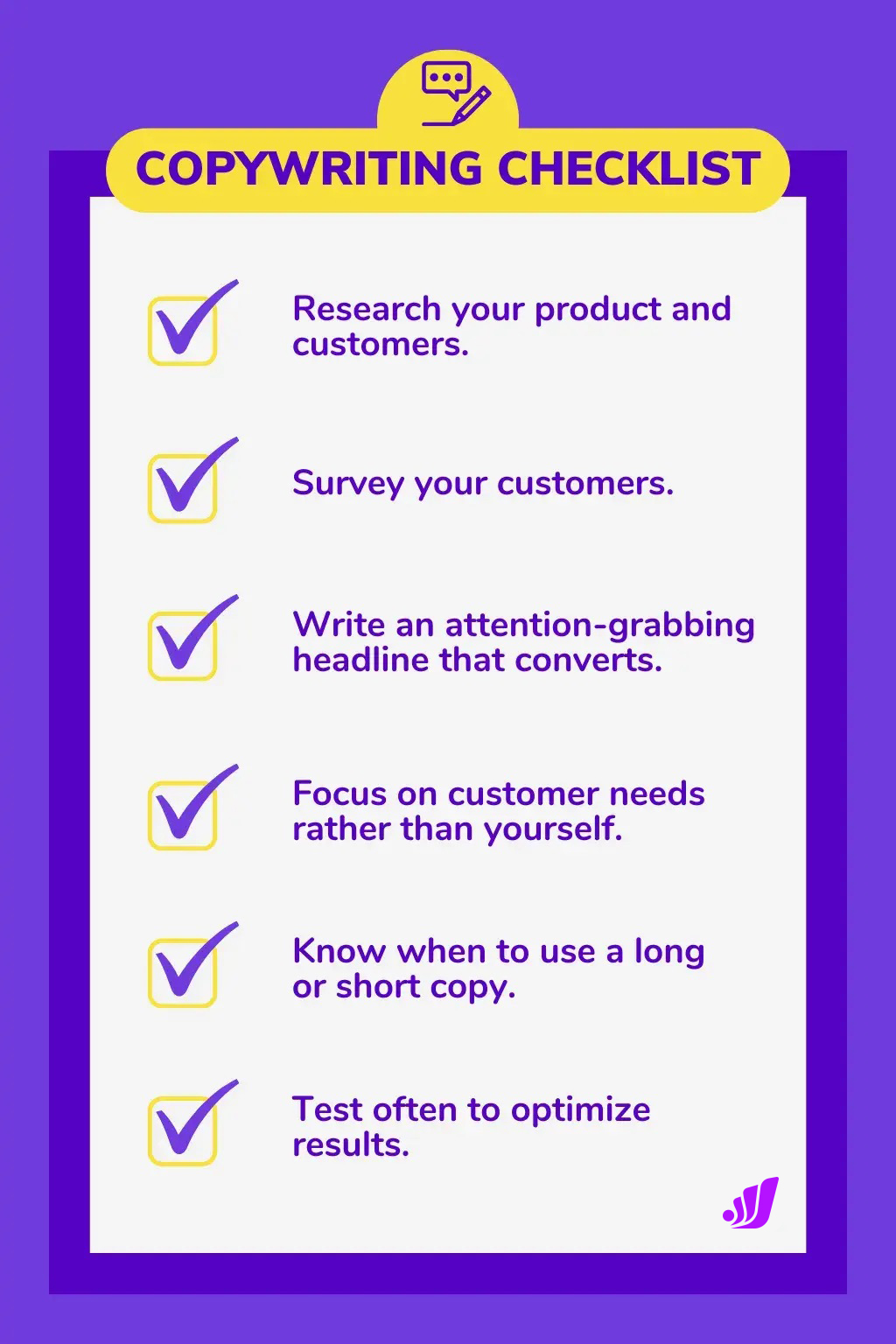
Now let’s look at some of the most common mistakes when writing copy.
Common Mistakes to Avoid When Writing Marketing Copy
When it comes to copywriting in marketing, mistakes can be costly. Even the most experienced copywriters make errors that can harm their marketing efforts.
Bad copy will fail to resonate with its target audience or achieve its intended purpose.
Here are some practices to avoid:
Lack of Audience Research
Failing to understand your target audience’s needs, preferences, and pain points can result in copy that is irrelevant or unappealing to them. Conduct thorough audience research to gain insights and tailor your copy accordingly.
Poor Structure and Organization
If your copy lacks a clear and logical structure, it can confuse and lose the interest of readers. Ensure your copy flows smoothly, with a coherent introduction, body, and conclusion that guide the reader through the intended message.
Excessive Use of Jargon
While industry-specific terms may be familiar to you, they can confuse or alienate your audience. Avoid using excessive jargon and technical language. Instead, aim for clear and accessible language that your target audience can easily understand.
Lack of a Compelling Hook
Your copy needs to grab the reader’s attention right from the start. Failing to create a strong hook or opening can result in your copy being overlooked or ignored. Craft a compelling headline or opening sentence that entices readers to continue reading.
Overemphasis on Features Rather Than Benefits
Your copy should focus on addressing the needs and desires of your customers, rather than solely promoting your company or product. Shift the spotlight to how your offering can solve problems or provide value to the customer.
Lack of Proof or Credibility
Failing to provide evidence or proof to support your claims can make your copy less convincing. Include testimonials, case studies, statistics, or other forms of social proof to establish credibility and build trust with your audience.
Not Proofreading
It may seem obvious but grammar and spelling mistakes can really undermine credibility in written communications, especially if you’re trying to sell something. Typos, bad spacing, wrong punctuation, and awkward phrasing can make your copy appear unprofessional and significantly impact the quality of your message.
Take time to proofread your work before hitting publish. Even better, enlist someone else’s help so they can catch any errors you might miss.
Ignoring the Importance of a Strong CTA
A clear and compelling call to action (CTA) is essential for guiding your audience toward a desired action. Neglecting to include a strong CTA or making it unclear can result in missed opportunities for conversions or engagement.

Source: Owner’s Mag
Not Optimizing Content
Without SEO knowledge, you could be missing out on potential traffic opportunities. Be sure relevant keywords appear naturally throughout your copy to boost visibility on search engines.
These are just some of the common mistakes that lead to bad copy. By avoiding them altogether, you can increase the chances of creating persuasive and impactful messaging that resonates with your audience and achieves your marketing goals.
Guide to Copywriting in Marketing: Improve Your Copy Right Now
Improving your craft is a continual process that involves practice, learning, and refining your techniques. Here are some ways to enhance your abilities in copywriting in marketing:
Study Successful Copy
Look at examples of effective copywriting. Analyze and deconstruct top-performing copy from various sources, including advertisements, sales letters, websites, and email campaigns. Look for patterns, persuasive techniques, and language styles that resonate with the audience. Learn from professional copywriters and follow their lead when crafting your own pieces of content marketing material.
Read Extensively
Expand your reading beyond copywriting books and delve into a wide range of subjects, including literature, non-fiction, and industry-related content. Reading exposes you to different writing styles, improves your vocabulary, and enhances your overall writing skills.
Practice Regularly
Every master copywriter started as a newbie. The best way to improve your copy is with practice.
Set aside dedicated time to write and experiment with different copywriting techniques. Challenge yourself to write persuasive copy for various scenarios, products, or services. The more you practice, the better you become at crafting compelling messages.
Every piece of copy you write won’t be perfect, but with time and effort, you will get better. Start with single-page blogs and work your way up to landing pages or white papers.
Research and Plan Ahead
Take the time to research and understand your target audience thoroughly. Learn about their demographics, motivations, pain points, and desires. This knowledge will help you tailor your copy to their specific needs, making it more compelling and persuasive.
Before you start writing, research your topic so you know what you are writing about. Write a blog outline and plan out how long each section should be before starting any project.
Develop Your Unique Voice
Find your own writing style and tone that aligns with your brand and resonates with your audience. Experiment with different approaches, and over time, you’ll develop a distinctive voice that sets you apart from others.
Master Headlines and Hooks
Capturing attention is crucial in copywriting in marketing. Invest time in crafting powerful headlines and hooks that immediately engage your readers. Study proven copywriting formulas in headline writing and experiment with different approaches to find what works best for your target audience.
Write for Clarity and Simplicity
Copywriting in marketing is not an avenue for showing off your vocabulary. Clear and concise copy is the best way to reach your audience.
Aim for clarity by using simple, jargon-free language. Break complex concepts into easily digestible chunks. Edit and revise your copy to eliminate unnecessary words and ensure your message is easily understood.
Be Conversational
Write the way that you talk. Use natural language that resonates with readers in a conversational tone. Spend more time researching and planning than actually writing for the best results.
Seek Feedback and Learn From It
Share your copy with others, whether it’s colleagues, mentors, or online communities, and ask for feedback. Be open to constructive criticism and learn from it. Understand what works and what can be improved, and apply those insights to refine your copywriting skills.
Stay Updated with Industry Trends
The world of copywriting in marketing is constantly evolving. Stay informed about the latest trends, techniques, and best practices in copywriting. Attend webinars, read blogs, and engage with industry experts to stay ahead of the curve.
While we’re talking about industry trends, we have to mention AI. Right now, artificial intelligence tools are taking over the copywriting world, turning even mediocre writers into wordsmiths.
BrandWell is a powerful brand growth platform that can write both long-form and short-form content — giving you a unified platform for copywriting and content marketing.
Here’s an example of an ad copy written by BrandWell’s AIMEE chatbot:
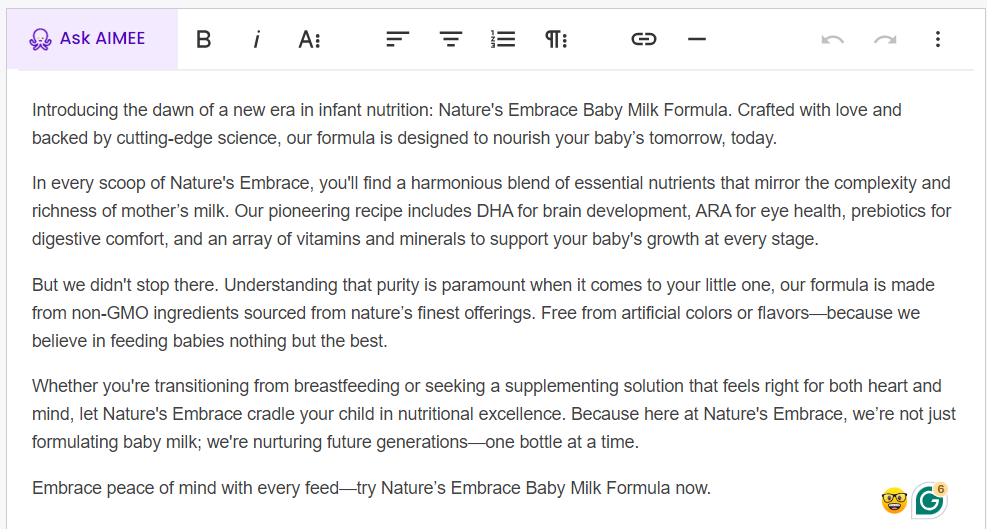
As a copywriter, what can you do to stay viable? Learn to work with, not against, AI.
Remember, improving your copywriting skills takes time and dedication. Continuously learn, practice, and refine your techniques to become a more effective and persuasive copywriter.
Learning from Top Copywriters in Marketing
You know what they say about standing on the shoulders of giants?
Well, it applies here too.
In this digital age where content is king and copywriting rules supreme, there are countless online masters whose work can be studied for improvement.
- Pick writers who resonate with your style or those whom you aspire to emulate.
- Read their works extensively — blog posts, email marketing materials, social media snippets; everything counts.
- Analyze how they handle an almost impossible copywriting task like turning a 50-word homepage copy into a conversion machine.
One more thing: Practice makes perfect.
If talented Don Draper could do it without Google, so can you.
Writing regularly helps hone your craft and sharpen your ability to persuade through words.
Remember, it’s not just about stringing together beautiful sentences but also ensuring your creative copywriting resonates with the audience you’re writing for.
FAQs – Guide to Copywriting in Marketing
How to do copywriting for marketing?
- Start with the end in mind.
- Refine your tone.
- Identify the problem you solve.
- Speak to consumers’ desires.
- Cut unnecessary words.
- Write for your target audience.
- Read your copy aloud.
- Use active voice.
What are the 6 core copywriting skills?
- Research skills.
- Staying up to date.
- Adaptability.
- Knowing your audience.
- Search engine optimization.
- Ability to hook the reader.
What are the four Ps of copywriting?
The 4 Ps of copywriting are Promise, Picture, Proof, and Push. They are more expansive elements of the four elements of Attention, Interest, Desire, and Action.
Conclusion
It’s important to understand the basics and develop a good understanding of what makes great copy. With this guide to copywriting in marketing, you can create compelling content that will help your business stand out from the competition.
Remember, practice makes perfect. By investing effort and dedicating time, you can learn the technique of copywriting to ensure that each copy is interesting and convincing.

UNLOCK YOUR POTENTIAL
Long Headline that highlights Value Proposition of Lead Magnet
Grab a front row seat to our video masterclasses, interviews, case studies, tutorials, and guides.

